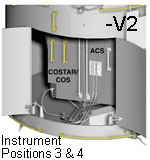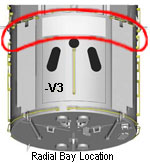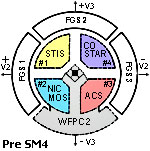|
axial bays (4) |
The axial bay is the bottom most area of Hubble and where four of the scientific instruments are housed. Double doors in the aft section on each side of Hubble provide access to this area. These four instruments are aligned with the main optical axis and
are mounted just behind the primary mirror. Each science instrument has an
entrance aperture, located in different portions of the Hubble's focal plane. As of mid-2008 they consists of:
|
ACS (Advanced Camera for Surveys): the newest camera (2002)
with a wider field of view, and better light sensitivity than WFPC2.
It effectively increases Hubble's discovery power by
10x. |
|
COSTAR (Corrective Optics Space Telescope Axial Replacement):
contains corrective optics for spherical aberration in the
primary mirror (technically, not an instrument).
COSTAR is to be replaced by the Cosmic Origins Spectrograph (COS) instrument in Servicing Mission 4.
COS (Cosmic Origins Spectrograph) (Post SM4) is an ultraviolet spectrograph optimized for observing faint point sources with moderate spectral resolution. |
|
NICMOS (Near Infrared Camera
and Multi-Object Spectrometer): Infrared instrument
that is able to see through interstellar gas and dust. |
|
STIS (Space Telescope Imaging Spectrograph): separates light
into component wavelengths, much like a prism. |


|
|
radial bay (4)
|
The radial bay is a donut-shaped reservour sitting above the axial bay and houses the remaining scientific instruments. Presently, Wide Field Planetary Camera 2 (WFPC2) occupies one of the four radial bays available on Hubble. WFPC2 is responsible for taking many of Hubble's famous pictures. WFPC2 is to be replaced by the next generation of camera, Wide Field Camera 3 (WFC3), in Servicing Mission 4.

The remaining three radial bays house the Fine Guidance Sensors (FGS), used primarily
to control pointing of the Telescope. The sensors are in the
focal plane structure, at right angles to the optical
path of the Telescope and 90 degrees apart and have pick-off mirrors to deflect
incoming light into their apertures. The sensors lock onto guide stars and measure relative positions, providing data to the spacecraft's targeting system and gathering
knowledge on the distance and motions of stars. When two FGSs lock on guide stars to provide pointing information for the Telescope, the third FGS serves as a science instrument to measure the position of stars in relation to other stars.
 
|